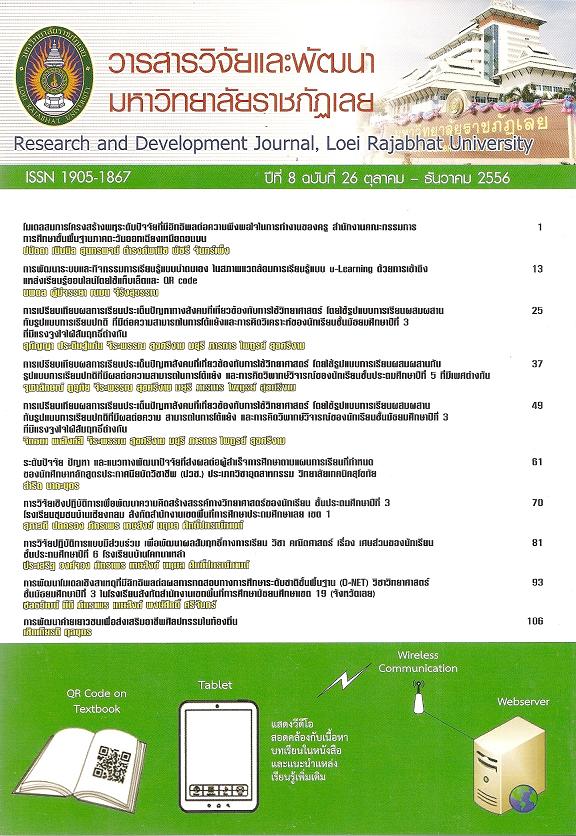การเปรียบเทียบผลการเรียนประเด็นปัญหาสังคมที่เกี่ยวข้องกับการใช้วิทยาศาสตร์ โดยใช้รูปแบบการเรียนผสมผสานกับรูปแบบการเรียนปกติที่มีผลต่อความสามารถในการโต้แย้ง และการคิดวิพากษ์วิจารณ์ของนักเรียนชั้นประถมศึกษาปีที่ 5 ที่มีเพศต่างกัน
Keywords:
ประเด็นปัญหาทางสังคมที่เกี่ยวข้องกับการใช้วิทยาศาสตร์, การเรียนแบบผสมผสาน, ความสามารถในการโต้แย้ง, การคิดเชิงวิพากษ์วิจารณ์, socioscientific issues, mixed method learning, argumentation, critical thinkingAbstract
บทคัดย่อ
การวิจัยครั้งนี้มีความมุ่งหมายเพื่อ 1) ศึกษาความสามารถในการโต้แย้งหลังเรียนประเด็นปัญหาทางสังคมที่เกี่ยวข้องกับการใช้วิทยาศาสตร์ ของนักเรียนที่จำแนกตามเพศและรูปแบบการเรียน 2) ศึกษาและเปรียบเทียบการคิดเชิงวิพากษ์วิจารณ์ก่อนและหลังเรียนประเด็นปัญหาทางสังคมที่เกี่ยวข้องกับการใช้วิทยาศาสตร์ ของนักเรียนโดยส่วนรวมและจำแนกตามตามเพศและรูปแบบการเรียน 3) เปรียบเทียบความสามารถการโต้แย้งและการคิดเชิงวิพากษ์วิจารณ์หลังเรียนประเด็นปัญหาทางสังคมที่เกี่ยวข้องกับการใช้วิทยาศาสตร์ ของนักเรียนที่มีเพศต่างกันและเรียนด้วยรูปแบบการเรียนต่างกัน กลุ่มตัวอย่างนักเรียนชั้นประถมศึกษาปีที่ 5 จำนวน 100 คน ได้จากการสุ่มแบบกลุ่ม แบ่งเป็น 2 กลุ่ม คือ กลุ่มทดลอง เรียนแบบผสมผสาน และกลุ่มควบคุม เรียนแบบปกติ การเก็บรวบรวมข้อมูล แผนการจัดการเรียนรู้ จำนวน 3 แผน คือการเลือกบริโภคพืชจีเอ็มโอ การสร้างรีสอร์ทในเขตป่าสงวนแห่งชาติ และการเลือกใช้วัสดุสังเคราะห์ในชีวิตประจำวันใช้เวลาเรียนแผนละ 3 ชั่วโมงต่อสัปดาห์ แบบประเมินความสามารถในการโต้แย้ง จำนวน 4 ฉบับ แบบทดสอบวัดการคิดวิพากษ์วิจารณ์มี 5 ด้าน จำนวน 30 ข้อ ได้แก่ ด้านอนุมาน ด้านการยอมรับข้อตกลงเบื้องต้น ด้านการนิรนัย ด้านการตีความและด้านการประเมินข้อโต้แย้ง สถิติที่ใช้ทดสอบสมมติฐานคือ Dependent t-test, F-test (Two-way MANCOVA and ANCOVA)
ผลการวิจัยพบว่า นักเรียนโดยรวม นักเรียนชายและนักเรียนหญิงหลังเรียนประเด็นปัญหาทางสังคมที่เกี่ยวข้องกับการใช้วิทยาศาสตร์โดยใช้รูปแบบการเรียนผสมผสานมีการพัฒนาความสามารถในการโต้แย้งมากขึ้น และมีการคิดเชิงวิพากษ์วิจารณ์ โดยรวมและเป็นรายด้านเพิ่มขึ้นจากก่อนเรียน (p<.05) (2) นักเรียนชายที่เรียนประเด็นปัญหาทางสังคมที่เกี่ยวข้องกับการใช้วิทยาศาสตร์มีการคิดเชิงวิพากษ์วิจารณ์เฉพาะด้านการตีความมากกว่านักเรียนหญิง (p<.05) (3) นักเรียนที่เรียนประเด็นปัญหาทางสังคมที่เกี่ยวข้องกับการใช้วิทยาศาสตร์โดยใช้รูปแบบการเรียนผสมผสานมีการคิดเชิงวิพากษ์วิจารณ์ด้านการยอมรับข้อตกลงเบื้องต้น และด้านนิรนัย มากกว่านักเรียนที่เรียนโดยใช้รูปแบบการเรียนปกติ (4) มีปฏิสัมพันธ์หระว่างเพศกับรูปแบบการเรียนต่อความสามารถในการโต้แย้งและการคิดวิพากษ์วิจารณ์โดยรวม และด้านการอนุมานและด้านการประเมินข้อโต้แย้ง (p<.05)
Abstract
This research aimed to 1) study the development of argumentation abilities after learning socioscientific issues of the students as a whole and as classified according to sex and learning method (2) study and compare critical thinking abilities before and after learning socioscientific issues of the students as a whole and as classified according to sex and learning methods, and 3) compare argumentation abilities and critical thinking abilities after learning socioscientific issues of the students with different sexes and learning methods. The sample consisted of 100 Prathomsuksa 5. Students who obtained using the cluster random sampling technique ; 2 groups using the mixed method and control group, and convertional learning method. Research instruments included lesson plans on 3 socioscientific issues: selection of genetically modified plants, resort construction in the natural forest and selection of synthetic materials in daily life, 3 plans using the mixed method and another 3 plans using the conventional method, each plan for 3 hours of learning in a week; 4 argumentation tests, 4 items each; and a critical thinking test with 5 subscales and 30 items: recognition of assumptions, inference, deduction, interpretation and evaluation of arguments.The hypotheses were tested using the dependent t-test and the F-test (Two-way MANCOVA and ANCOVA).
The findings revealed the following: (1)The whole students, the male students, and the female students who learned the socioscientific issues using the mixed method showed developments of argumentation abilities from the 1st test to the 4th test; and indicated gains in critical thinking abilities in general and in each subscale form before learning at the .05 level of significance.(2) The male students only showed more critical thinking in the interpretation subscale than the female students at the .05 level of significance. (3) The experimental group students evidenced more critical thinking in 2 subscales: recognition of assumptions and deduction, than the control group students at the .05 level of significance. (4) Statistical interactions of sex with learning method on the argumentation and the critical thinking in general and 2 subscales: inference and evaluation of arguments were found to be significant (P<025).
Downloads
How to Cite
Issue
Section
License
ข้อความที่ปรากฎในวารสารฉบับนี้เป็นความคิดเห็นของผู้เขียนแต่ละท่าน สถาบันวิจัยและพัฒนา มหาวิทยาลัยราชภัฏเลย และกองบรรณาธิการ ไม่จำเป็นต้องเห็นด้วยและไม่มีส่วนรับผิดชอบใดๆ
สถาบันวิจัยและพัฒนา มหาวิทยาลัยราชภัฏเลย ขอให้ผู้อ่านอ้างอิงในกรณีที่ท่านคัดลอกเนื้อหาบทความในวารสารฉบับนี้






